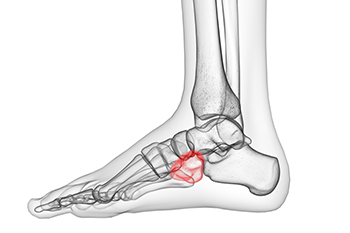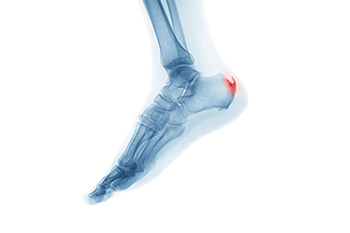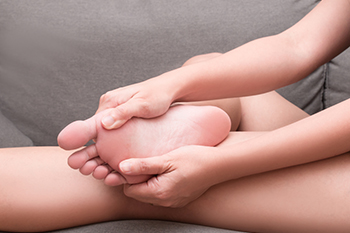Connect With Us
Items filtered by date: July 2022
Heel Pain Can Be Treated!
What Is Cuboid Syndrome?

In cuboid syndrome, the small, square-shaped cuboid bone on the outside of the midfoot becomes partially dislocated. Cuboid syndrome can cause foot pain in this area, along with weakness in the foot. This condition may occur when the ankle has been sprained or twisted, through overuse/repetitive strain, or by having flat feet. Along with pain and/or foot weakness, there may be redness, swelling, or bruising on the outside of the midfoot. If you suspect that you have cuboid syndrome, contact a podiatrist. They will examine to see exactly where the pain is emanating from. If they determine that you have cuboid syndrome, they may try to treat it with rest, ice therapy, orthotics, and taping. They may even determine that manipulating the bone back into alignment is possible with procedures known as the cuboid whip or the cuboid squeeze. Manipulation is more successful if it is performed shortly after the injury has occurred, so it is important to seek treatment from a podiatrist as soon as possible.
Cuboid syndrome, also known as cuboid subluxation, occurs when the joints and ligaments near the cuboid bone in the foot become torn. If you have cuboid syndrome, consult with one of our podiatrists from The Podiatry Center, PC. Our doctors will assess your condition and provide you with quality foot and ankle treatment.
Cuboid syndrome is a common cause of lateral foot pain, which is pain on the outside of the foot. The condition may happen suddenly due to an ankle sprain, or it may develop slowly overtime from repetitive tension through the bone and surrounding structures.
Causes
The most common causes of cuboid syndrome include:
- Injury – The most common cause of this ailment is an ankle sprain.
- Repetitive Strain – Tension placed through the peroneus longus muscle from repetitive activities such as jumping and running may cause excessive traction on the bone causing it to sublux.
- Altered Foot Biomechanics – Most people suffering from cuboid subluxation have flat feet.
Symptoms
A common symptom of cuboid syndrome is pain along the outside of the foot which can be felt in the ankle and toes. This pain may create walking difficulties and may cause those with the condition to walk with a limp.
Diagnosis
Diagnosis of cuboid syndrome is often difficult, and it is often misdiagnosed. X-rays, MRIs and CT scans often fail to properly show the cuboid subluxation. Although there isn’t a specific test used to diagnose cuboid syndrome, your podiatrist will usually check if pain is felt while pressing firmly on the cuboid bone of your foot.
Treatment
Just as the range of causes varies widely, so do treatments. Some more common treatments are ice therapy, rest, exercise, taping, and orthotics.
If you have any questions, please feel free to contact our office located in Millburn, NJ . We offer the newest diagnostic and treatment technologies for all your foot care needs.
Do I Have a Heel Spur?

A common reason that people can have heel pain may be related to heel spurs. It is defined as a calcium deposit that develops on the bottom of the heel, and sometimes causes severe pain and discomfort. The band of tissue that runs along the sole of the foot is known as the plantar fascia. This helps the foot to withstand daily walking and standing, in addition to supporting the arch of the foot. If it is stretched beyond its limitations from overuse, the body may naturally respond by building extra bone, which is known as a heel spur. Contributing factors that may lead to this condition include wearing shoes that do not fit correctly, obesity, and advanced age. Common symptoms of a heel spur are pain in the bottom of the heel that can worsen while walking or running, and feeling a bump when the heel is touched. Mild relief may come from resting the affected foot as often as possible, and it can help to temporarily cut back on exercise as the foot heals. If you have heel pain, it is strongly suggested to consult with a podiatrist who can properly diagnose and treat heel spurs.
Heel spurs can be incredibly painful and sometimes may make you unable to participate in physical activities. To get medical care for your heel spurs, contact one of our podiatrists from The Podiatry Center, PC. Our doctors will do everything possible to treat your condition.
Heels Spurs
Heel spurs are formed by calcium deposits on the back of the foot where the heel is. This can also be caused by small fragments of bone breaking off one section of the foot, attaching onto the back of the foot. Heel spurs can also be bone growth on the back of the foot and may grow in the direction of the arch of the foot.
Older individuals usually suffer from heel spurs and pain sometimes intensifies with age. One of the main condition's spurs are related to is plantar fasciitis.
Pain
The pain associated with spurs is often because of weight placed on the feet. When someone is walking, their entire weight is concentrated on the feet. Bone spurs then have the tendency to affect other bones and tissues around the foot. As the pain continues, the feet will become tender and sensitive over time.
Treatments
There are many ways to treat heel spurs. If one is suffering from heel spurs in conjunction with pain, there are several methods for healing. Medication, surgery, and herbal care are some options.
If you have any questions feel free to contact our office located in Millburn, NJ . We offer the latest in diagnostic and treatment technology to meet your needs.
Plantar Warts Can Be Treated!
Sesamoiditis: A Common Running Injury

Sesamoiditis is an injury that affects many runners, particularly those who train on hard surfaces or rocks. Sesamoiditis occurs when the two tiny sesamoid bones that reside under the big toe get fractured and/or the tendons around the sesamoids become irritated and inflamed. Sesamoiditis may occur from the repeated impact a runner’s foot makes with the ground, or from other factors such as having tight toe flexors. Pain from sesamoiditis can be sharp and sudden, and is usually felt underneath the big toe or in the ball of the foot. If it feels like a burning pain, this may indicate nerve damage. A podiatrist can treat sesamoiditis with recommendations of rest, along with prescribing anti-inflammatory medications and reducing inflammation with other methods.
Sesamoiditis is an unpleasant foot condition characterized by pain in the balls of the feet. If you think you’re struggling with sesamoiditis, contact one of our podiatrists of The Podiatry Center, PC. Our doctors will treat your condition thoroughly and effectively.
Sesamoiditis
Sesamoiditis is a condition of the foot that affects the ball of the foot. It is more common in younger people than it is in older people. It can also occur with people who have begun a new exercise program, since their bodies are adjusting to the new physical regimen. Pain may also be caused by the inflammation of tendons surrounding the bones. It is important to seek treatment in its early stages because if you ignore the pain, this condition can lead to more serious problems such as severe irritation and bone fractures.
Causes of Sesamoiditis
- Sudden increase in activity
- Increase in physically strenuous movement without a proper warm up or build up
- Foot structure: those who have smaller, bonier feet or those with a high arch may be more susceptible
Treatment for sesamoiditis is non-invasive and simple. Doctors may recommend a strict rest period where the patient forgoes most physical activity. This will help give the patient time to heal their feet through limited activity. For serious cases, it is best to speak with your doctor to determine a treatment option that will help your specific needs.
If you have any questions please feel free to contact our office located in Millburn, NJ . We offer the newest diagnostic and treatment technologies for all your foot and ankle needs.
Signs of Possible Stress Fractures

Stress fractures of the feet are particularly tricky to recognize. They are hairline cracks in the bones, frequently the long metatarsal bones in the midfoot and the calcaneus bone in the heel. They are considered repetitive injuries and that means the more you repeat an activity, the worse they become. But it can take a while before you even notice the problem. Signs that may help to identify a stress fracture include a deep ache in the foot, a dull pain midway into the activity that fades when you rest, and a pain that just doesn’t go away. Other hints are pain that occurs even when you are not active, pain that worsens at night, and pain that begins about a week after increasing your activity level. Treatment for stress fractures may take weeks or even months. As soon as you recognize that something is wrong, it is a good idea to stop the activity causing the pain and make an appointment with a podiatrist for a full examination.
Stress fractures occur when there is a tiny crack within a bone. To learn more, contact one of our podiatrists from The Podiatry Center, PC. Our doctors can provide the care you need to keep you pain free and on your feet.
How Are They Caused?
Stress fractures are the result of repetitive force being placed on the bone. Since the lower leg and feet often carry most of the body’s weight, stress fractures are likely to occur in these areas. If you rush into a new exercise, you are more likely to develop a stress fracture since you are starting too much, too soon. Pain resulting from stress fractures may go unnoticed at first, however it may start to worsen over time.
Risk Factors
- Gender – They are more commonly found in women compared to men.
- Foot Problems – People with unusual arches in their feet are more likely to develop stress fractures.
- Certain Sports – Dancers, gymnasts, tennis players, runners, and basketball players are more likely to develop stress fractures.
- Lack of Nutrients – A lack of vitamin D and calcium may weaken the bones and make you more prone to stress fractures
- Weak Bones – Osteoporosis can weaken the bones therefore resulting in stress fractures
Stress fractures do not always heal properly, so it is important that you seek help from a podiatrist if you suspect you may have one. Ignoring your stress fracture may cause it to worsen, and you may develop chronic pain as well as additional fractures.
If you have any questions, please feel free to contact our office located in Millburn, NJ . We offer the newest diagnostic and treatment technologies for all your foot care needs.
Blog Archives
- June 2025
- May 2025
- April 2025
- March 2025
- February 2025
- January 2025
- December 2024
- November 2024
- October 2024
- September 2024
- August 2024
- July 2024
- June 2024
- May 2024
- April 2024
- March 2024
- February 2024
- January 2024
- December 2023
- November 2023
- October 2023
- September 2023
- August 2023
- July 2023
- June 2023
- May 2023
- April 2023
- March 2023
- February 2023
- January 2023
- December 2022
- November 2022
- October 2022
- September 2022
- August 2022
- July 2022
- June 2022
- May 2022
- April 2022
- March 2022
- February 2022
- January 2022
- December 2021
- November 2021
- October 2021
- September 2021
- August 2021
- July 2021
- June 2021
- May 2021
- April 2021
- March 2021
- February 2021
- January 2021
- December 2020
- November 2020
- October 2020
- September 2020
- August 2020
- July 2020
- June 2020
- May 2020
- April 2020
- March 2020
- February 2020
- January 2020
- December 2019
- November 2019
- October 2019
- September 2019
- August 2019
- July 2019
- June 2019
- May 2019
- April 2019
- March 2019
- February 2019
- January 2019
- December 2018
- November 2018
- October 2018
- September 2018
- August 2018
- July 2018
- June 2018
- May 2018
- April 2018
- March 2018
- February 2018
- January 2018
- December 2017
- November 2017
- October 2017
- September 2017
- August 2017
- July 2017
- June 2017
- May 2017
- April 2017
- March 2017
- February 2017
- January 2017
- December 2016
- November 2016
- October 2016
- September 2016
- August 2016
- July 2016
- June 2016
- May 2016
- April 2016
- March 2016
- February 2016
- January 2016
- December 2015
- November 2015
- October 2015
- September 2015
- August 2015
- July 2015
- June 2015
- May 2015
- January 2014
- December 2013
- November 2013
- October 2013
- September 2013
- August 2013
- July 2013
- June 2013
- May 2013
- April 2013
- March 2013
- February 2013
- January 2013
- December 2012
- November 2012
- October 2012
- September 2012
- August 2012
- July 2012
- June 2012


